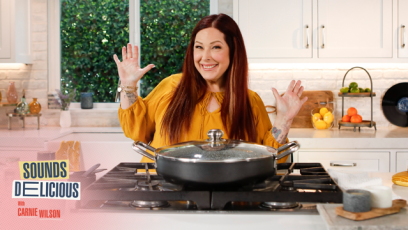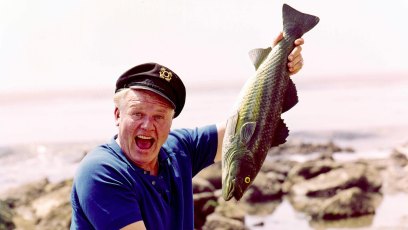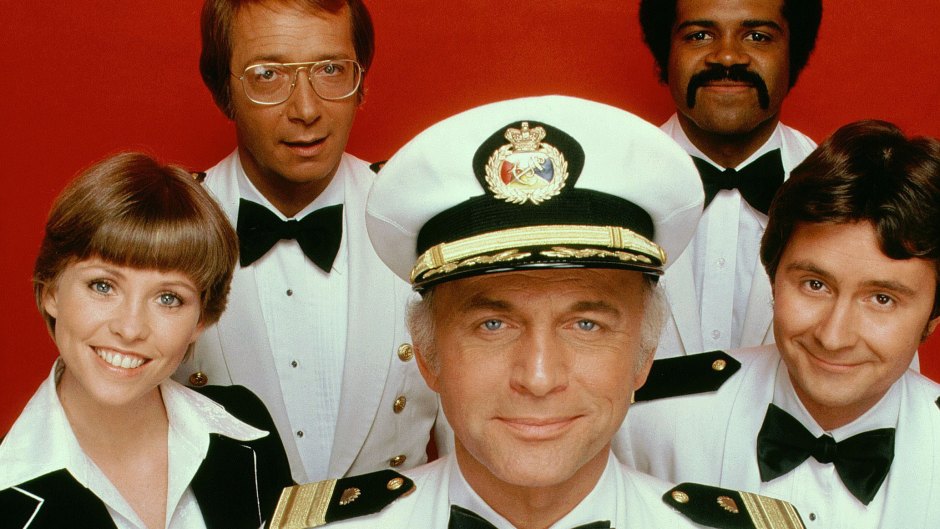
Aaron Spelling/Love Boat/Kobal/Shutterstock
Get Ready to Set Sail on ‘The Love Boat’ For a Behind the Scenes Look at Romance On the High Seas
CBS may have owned Saturday nights in the first half of the 1970s with series like All in the Family, The Mary Tyler Moore Show and The Carol Burnett Show, but ABC took the crown in the latter half of the decade with the one-two punch of The Love Boat and Fantasy Island. And that’s especially true when it comes to The Love Boat, which took viewers on romantic cruises to domestic and foreign destinations between 1977 and 1986.
“The Love Boat brought those locations to American living rooms and a lot of people who couldn’t afford to go to or had never been to these places,” observes Jim Colucci, author of Golden Girls Forever: An Unauthorized Look Behind the Lanai and who is currently writing the ultimate companion to The Love Boat. “In a lot of ways, the show really kind of opened our eyes, but what it really did was to cheer us up from the winter doldrums. On a Saturday night you could escape the snow of New Jersey, where I was, and end up either in Mexico or the Mediterranean or Australia. It was wonderful and people loved it.”
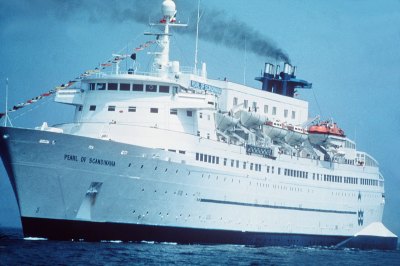
The show, which is currently airing on the MeTV Network, is set aboard the luxury passenger cruise ship S.S. Pacific Princess, brought together a regular cast consisting of Captain Merrill Stubing (Gavin MacLeod, fresh off of The Mary Tyler Moore Show), Bernie Kopell (Siegfried from Get Smart!) as Dr. Adam “Doc” Bricker, Ted Lange as bartender Isaac Washington, Fred Grandy as Burl “Gopher” Smith, the yeoman purser; Lauren Tewes as cruise director Julie McCoy, Jill Whelan as Vicki Stubing, the captain’s daughter; Ted McGinley as ship photographer Ashley “Ace” Covington Evans; and Pat Klous as Judy McCoy, Julie’s sister and eventual replacement. And they would be joined by celebrity guest stars from different era who would interact with the crew, but be involved primarily in their own stories (usually three per episode).

Given the nature of the show, Jim sensed he had his work cut out for him in telling its story, a point made evident by the fact he’s already interviewed over 200 people and is still going strong. “I knew doing a book about a sitcom would be like doing a 500-piece puzzle,” he says, “and doing a book about The Love Boat is like a 5,000-piece puzzle, because the stories are so much more finely scattered among many more people and you don’t know who has a story until you’ve got them on the phone. So it’s been a treasure hunt.”
And to go on that treasure hunt, please scroll down.
Be sure to check out and subscribe to our Classic TV & Film Podcast for interviews with your favorite stars!
1 of 26

Aaron Spelling/Love Boat/Kobal/Shutterstock
Why ‘The Love Boat’
“When I looked at a list of shows that I would really want to spend time with, it wouldn’t be a current show,” explains Jim. “It would be a show that hasn’t been covered like Friends and Seinfeld, which of course are some of my favorites and I would’ve loved to have done. And it really just brought me back to The Love Boat. There was a moment after I decided to do it that there was a meme going around virally on Facebook and other social media where you could put yourself in The Love Boat opening credits. I thought that was a good sign that other people love this show like I do.”
2 of 26

Aaron Spelling/Love Boat/Kobal/Shutterstock
Greater Appreciation
“I’m so happy to spend time with it and have uncovered so much that I didn’t know. And that gave me a new respect for the show, because I used to respect it as a silly, camp, guilty pleasure — and I still do — but now I have actual respect for some of the things they did,” he elaborates. “And that’s a joy to find when you’re doing a book, because it’s one thing to write a camp fest and you could do a book that way, but it’s another thing where you can do a camp fest and yet still put in stuff about how it was groundbreaking.”
3 of 26

Bei/Shutterstock
The Challenges of Telling This Story
Having embarked (oh, we went there) on this voyage (again!), Jim has interviewed over 200 people, including the main cast, guest stars, crew, producers, wardrobe and so on. “It’s a tricky book, because it’s a different muscle than writing about a sitcom like Will & Grace, which was still in production when I wrote Will and Grace: Fabulously Uncensored, or The Golden Girls, which has never stopped airing six times a day since it was first on and so it’s very fresh in people’s minds. Much more so than episodes of The Love Boat, which haven’t been airing as much, unfortunately.”
4 of 26

Moviestore/Shutterstock
So Many Actors!
“A sitcom is also different, because if you’re a guest star on a sitcom, you’re probably one of very few or maybe the only guest star,” Jim notes. “You probably spend the entire week in somewhat intense rehearsal with the main cast, you have your scenes in front of an audience and it’s all very memorable. The Love Boat was different. You were one of eight or 10 guest stars, you were in just one of the three vignettes within the episode. You probably had scenes with only one or two of the main cast members and were probably only there for a few days of the production week. Everybody would shoot the boardings and disembarkments on one day, there’d be a dining room day, there would be days when everybody would be there, but you wouldn’t even be on set at the same time, because if they weren’t shooting your chunk of the dining room scene, other people could be offset and then they’re in their dressing rooms. Like I said, it’s a treasure hunt.”
5 of 26

Casey Rodgers/Invision/AP/Shutterstock
It Began With ‘Love Boats’
The first clue of that treasure hunt is the fact that The Love Boat is actually based on a non-fiction book called Love Boats, written by the late Jeraldine Saunders, who served as a real-life cruise director. “I haven’t been able to prove this,” says Jim, “but she was supposed to be the first female cruise director. And if you read her book, you’ll see why she would be, if not the first, one of the first. And probably was the first, because back in the days following World War II, cruising was really dying, because airplanes were where it was at. Cruising was viewed as old-fashioned and certainly took a lot longer if you used it for actual transportation to a destination. On top of that, there were few boats anyway. Then think about how women were treated back in those days. Would a woman really want to subject herself to being on a boat full of male sailors and all of the dangers that could come with that?”
6 of 26

Chris Pizzello/Invision/AP/Shutterstock
For Jeraldine, Cruising Was Not a Fun Experience
“And if you read her book, you can see that there’s a great potential for a TV show, but maybe not this TV show, because there are many sexual assaults or near sexual assaults that take place in her book,” Jim notes. “Situations where a male coworker would let himself into her room, hide in the shower and wait for when she came back to her room. Or somebody would wait until she was walking down a narrow passageway and grab her. Unfortunately, if she did complain to the captain or anyone else, their attitude would be, ‘Well, that’s why women shouldn’t be on ships.’ It’s obvious why it wasn’t an attractive role for a woman. She made the best of it.”
7 of 26

Mike Nelson/EPA-EFE/Shutterstock
Pure Determination
At the same time, he observes, reading the book gives you a sense of the kind of person the author was, proving herself the epitome of the phrase “fake it until you make it.” Jim explains, “She was a single mom and had financial struggles. She got into this job because it required her to speak all of these foreign languages and be able to arrange things like tournaments and shore excursions and be able to physically do things like dance and play ping pong or whatever, and she didn’t know how to do any of this stuff. She just figured it out along the way. There were cases in the show where you’d see Julie would be in charge of the entertainment, which was a real duty of the cruise director, and if the entertainment flaked out or something went wrong, Gerri would have to just come up and act and get on stage and do something. So her book is fascinating in that way.”
8 of 26

CBS Television Distribution
Sailing to Hollywood
It certainly caught the attention of Douglas S. Cramer, a former Paramount executive who oversaw the production of shows like The Brady Bunch, The Odd Couple and Love, American Style, the latter of which is a romantic comedy anthology presenting two to four stories per episode and featuring a wide array of guest stars. Having shifted to the role of executive producer with Love, American Style, when that show ended he heard about Jeraldine’s book and thought it would make a natural successor to that series. Says Jim, “He kind of had a vision for how it could be a show and he told me a story that I’ll tell in my book about how someone else had the same idea at the same time, and it was really a race to get to Geraldine and get the option on the book, but he prevailed and ended up making the first pilot.”
9 of 26

CBS Television Distribution
TV Movies
In 1976, ABC aired a TV movie called The Love Boat, which was the basic premise and format we know and featured guest stars like Don Adams, Tom Bosley, Florence Henderson, Hal Linden and Karen Valentine. But the main cast included Ted Hamilton as Captain Thomas Ford, Dick Van Patten as ship’s doctor, O’Neil; Teddy Wilson as bartender Isaac and Terri O’Mara as cruise director Gerry. Ratings were strong and this was followed by The Love Boat II in 1977, which saw the final cast starting to come together. It features Bernie Kopell, Ted Lange and Fred Grandy. Diane Stilwell was cast as cruise director Sandy Summers, while Quinn K. Redeker was Captain Madison.
10 of 26

Aaron Spelling/Love Boat/Kobal/Shutterstock
Third Time’s the Charm
Also in 1977 came the final TV movie, The New Love Boat, which brought aboard Gavin McLeod as Captain Stubing, Laren Tewes as Julie McCoy and executive producer Aaron Spelling, who was riding high at the time with Starsky and Hutch and Charlie’s Angels, among others. Finally, ABC gave the green light for The Love Boat to go to series and a lot of the credit for that has to go to Aaron. “He brought clout,” states Jim. “I think it was really through his clout that they got a chance to take a third swing at the premise. Aaron was so successful with ABC already and it was a fruitful partnership. His partnership with Douglas Cramer was new and it was lightning in a bottle when the two of them met. Spelling had the clout to say, ‘Let’s do this again.’ On top of that, he had a reputation for treating actors well and a database of actors he could go to. Then he meets Cramer, who has this good idea and has really good taste. You put them together and it just kind of blended the right way.”
11 of 26

CBS Television Distribution
Locking Down the Final Cast Members
“As the films went on, you could see the final cast coming together,” Jim points out. “In the second movie, they didn’t have the captain or Julie, and those were the two hardest to cast. With someone like the captain, you had to find someone who was authoritative, but could also be what he proved to be later, a mushball in terms of the love theme of the show and someone who was instantly likable and could convey that. And with Julie, she had to have a girl next door kind of quality, which is very hard to find and capture. So they didn’t get it ‘right’ until the third film. Now, I didn’t think that the people in the first two films were bad — I particularly liked the cruise director women, and in some cases the writing was a little edgier for them, but it wasn’t what we came to love about the show. So someone had a good eye.”
12 of 26

Nick Ut/AP/Shutterstock
Celebrities Then and Now
One of the appeals of the show, he notes, is the star factor and a sense of Hollywood grandeur all of those guest stars brought with them. “One of the magic things that I always loved about the show, and that I knew I would find when I started researching, is that by virtue of the show being in production in the seventies and eighties, it was perfectly positioned to be on the cusp of two generations. So they could give early jobs to some of today’s biggest actors, like Tom Hanks, Kathy Bates, Courtney Cox, Teri Hatcher, and then you see them crossing paths with the giants of the silver screen who were alive and well, but due to ageism weren’t working that much and they wanted to work.”
13 of 26

Moviestore/Shutterstock
Isn’t That …?
“The Love Boat,” Jim continues, “gave a lot of those really wonderful stars an opportunity to come back and take another turn at bat. Sometimes they’d go on and do other stuff, too, but sometimes it was almost coming out of retirement for one final bow. And those people were so grateful for that opportunity and that old fashioned Hollywood grandeur; they knew they would be taken care of by Aaron Spelling’s company along with Doug Cramer, who was a great old movie fan. And so they knew the hair and makeup teams were top notch, they knew that the wardrobe people would make them look their best. The actors, particularly women, who would be worried about their appearances, looked absolutely incredible. And so when these old stars would be approached, so many people who you thought would never have done television or would think, ‘I don’t want to do some cheesy show,’ as America always viewed The Love Boat, would do it, because they would sometimes get a first class trip somewhere sometimes, and even if they didn’t leave the soundstage, they’d get first-class treatment and be adored.”
14 of 26

CBS Television Distribution
A Shipboard Who’s Who
Notes Jim, “And that’s why we have so many amazing stars of yesteryear captured like a time capsule on The Love Boat, and I loved that. I mean, Olivia de Haviland was on it and Joan Fontaine, her sister, did separate episodes. We had Luise Rainer, who was one of the first Oscar winners ever. Then there was Ginger Rogers … I could go on to the sirens of the silver screen and the men of the silver screen. For me it’s funny, because it’s like a pop culture fever dream. You see people like Scott Baio or Kristy McNichol or somebody who seems so of-the-moment at the time interacting with one of the most famous women who had ever been on the silver screen in the same episode, and, again, I think to myself, ‘Am I dreaming this?’”
15 of 26

CBS Television Distribution
Defying Creative Fatigue
There’s no denying that The Love Boat was formulaic in its approach, yet it someone managed to stay on the air for so many years, raising the question of how it avoided burning itself out quickly. “The escapism is a really powerful tool that so many people I talked to brought up,” details Jim. “As I said, if it’s February and you want to get away from your life for an hour on a Saturday night and watch someone in his or her bathing suit, sun tanning in Mexico, there’s some titillation in that. They always had beautiful people in bathing suits. On top of that, what I heard from so many people, both regular viewers and people who were guest stars on the show, and it was certainly true of me as a kid, you tuned in on Saturday night because you wanted to see who was on the show. You know, ‘Oh my God, look at him. Oh my God, look at her.’ It was just great. So it was a great surprise to see what new permutation of all your favorite people would be in a love story.”
16 of 26

CBS Television Distribution
Keeping Things Fresh
He adds, “While you can’t underestimate the power of escapism, they did take pains to keep it fresh so that it wouldn’t grow stale. That’s why they went to ever more exotic ports of call on those special actual cruises. It’s why in the ninth season they shook things up, rerecording the theme song, adding the Mermaid dancers, a few seasons earlier they had added Ted McGinley as a new character, Ace, the photographer. So there was change along the way in an effort to keep it fresh. Eventually, after nine years, it was starting to run its course, but that was a long time.”
17 of 26

CBS Television Distribution
Exotic Ports of Call
One of the things that was done as soon as as it was obvious how successful the show was, was to start filming a number of episodes per season on actual cruises. Points out Jim, “When you’re watching some of the early episodes, you’ll see those nighttime process shots where everybody’s standing in front of a moonlight sea that is clearly rear-projection, but in the same episode you’ll see a shot during the day that’s clearly done on a moving ship at sea. So you’ll think, ‘Did they shoot at sea or not?’ And that’s the way the show proceeded in the beginning, but in becoming a hit, they had a lot of leeway with the network. Aaron Spelling already had so much power with the network in making money and getting ratings, that they were able to really break out of the studio. And the cruises would get more and more exotic. They’d start with Alaska and then they started branching out to the Caribbean and eventually went to Australia, the Mediterranean, Scandinavia, Japan, China — I think they were the first Western show to shoot in China.”
18 of 26

Liu Heung Shing/AP/Shutterstock
Shooting Around the World
Adds Jim, “So the way they did that was to go out on these exotic cruises and they did several back to back. For example, the Japan, Hong Kong and China cruises are all separate episodes, but they were all shot at the same time. They would just fly one cast in and cruise part of it, slide that cast out, fly another cast in to cruise for the next segment of it and so on. Sometimes they’d have to switch boats for all kinds of convoluted reasons onscreen, like they were trading with another company and going to go on somebody else’s boat. But in off screen cases, like Egypt, standard cruise ships are too large to go down the Nile, so they would trade with a small company and get a boat all to themselves to go down the Nile. Then in the Mediterranean, they’d use a local cruise line. So there were all kinds of machinations behind the scenes. But it worked.”
19 of 26

Moviestore/Shutterstock
‘Love Boat Revelations’
As is the case during the interview process for any book, there have been a number of never-before-revealed behind the scenes stories that Jim has uncovered. “There were always ‘incidents,’” he says. “One in particular didn’t get a lot of press at the time, but you can see it in the episodes if you watch for it. They were filming in the Aegean on a cruise ship and the Turkish government body of one of the towns wanted to throw a welcome reception for the cast and crew. They’re at this party around a pool and the cast started to get the sense that something was weird, because people were kind of pawing at them and they were getting uncomfortable. Turns out that the governing body had invited the general public to meet the Love Boat stars and people were really getting aggressive with them.”
20 of 26
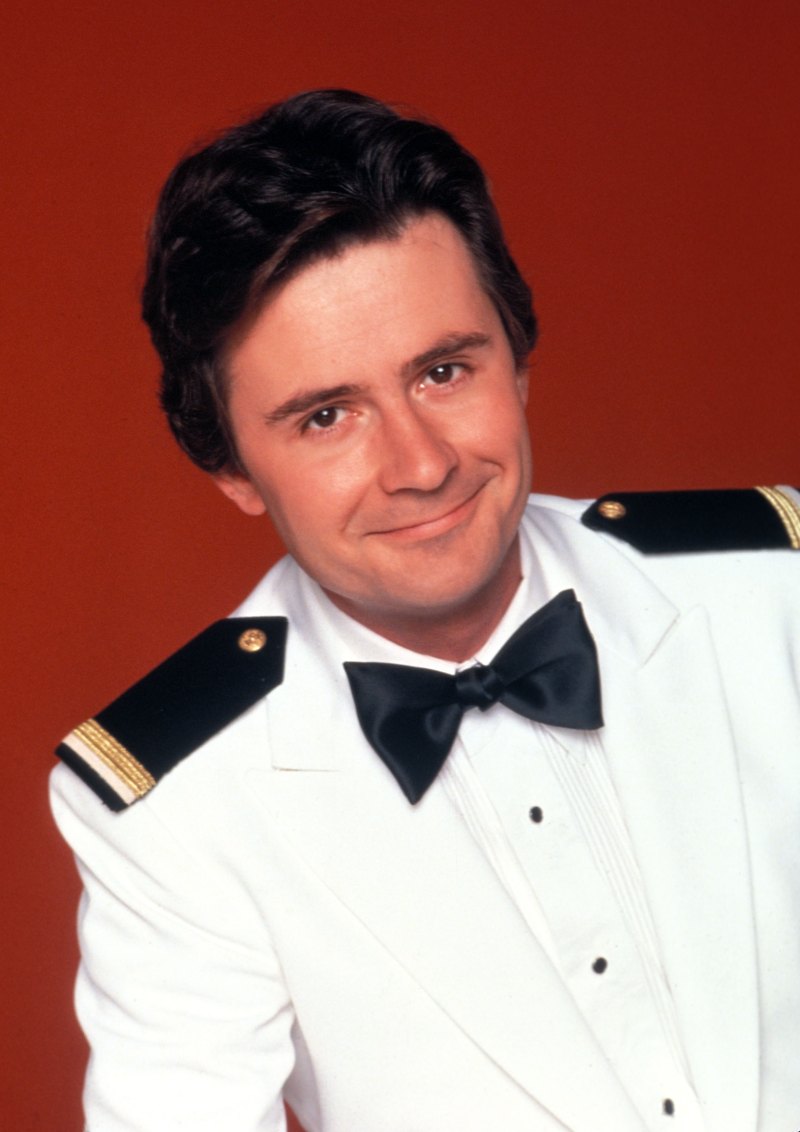
Aaron Spelling/Love Boat/Kobal/Shutterstock
Near Deadly Incident
The cast decided to leave, with Fred Grandy, Lauren Tewes, Lauren’s boyfriend and Ted Lange getting into a cab with some balloons from the party. Explains Jim, “At the time in Turkey, balloons were not filled with helium, but with hydrogen. They get in the car with these balloons and Fred Grandy lights up a cigarette and the cab explodes — they were engulfed in a fireball. Lauren was burned a little, her boyfriend mostly escaped burns, Ted Lange was in the front seat with the cabbie and so his hair was singed, but Fred Grandy was burned severely on his hands and his face. They actually didn’t know if he was alive when the fire went out and they rushed him back to the ship, because they were in a an area where they didn’t know if there were doctors or hospitals around.”
21 of 26

Aaron Spelling/Love Boat/Kobal/Shutterstock
Recovery
Fred received medical attention and was in agony for days, but, says Jim, “being a trooper, he did continue to shoot the moment they needed him. You look in the episode, Fred as Gopher is wearing white gloves and they had to write a line in there where somebody asks him about it and he says, ‘Oh, I have poison ivy.’ It’s because he had severe third degree burns on his hands and his face, too. In fact, they had to try to find special makeup they could apply that wouldn’t put him in further agony. They also had to try to not shine the lights on him, because he was in such pain. So there were incidents like that. There were also stories about guest stars who didn’t get along, like Lana Turner and Farley Granger, who hated each other and were kind of sneering at each other. Part of it was for comic effect, but there was some truth to it, too.”
22 of 26

Moviestore/Shutterstock
Encountering Lauren Tewes
“Lauren Tewes was very open back in the day, and now as well, about having been let go for having a drug problem,” he adds. “TV Guide even did a story on it. There’s probably a little bit more to it than that in terms of why she was fired and when, but what I loved about talking with her is that, as you know, when you do an interview and you have a sensitive topic to bring up, you kind of save it for last. They could get mad and hang up. So I’m sitting there thinking, ‘How am I going to approach this?’ Because I normally wouldn’t ask anybody about their addictions; that’s not my thing. But then she brought it up and was completely open and honest and really brutally truthful and critical of herself when it was warranted. I respect her so much for that. I ended up having a great time talking to her.”
23 of 26

CBS Television Distribution
‘The Love Boat’ Endures
It makes sense that during its original network run The Love Boat connected because it offered escapism, but what’s Jim’s feeling about the show today? “My feeling is that I’m … happy,” he offers simply. “I now know more about it than the average person and I’m happy to share with the world what I’ve discovered. On the plus side, if you say to anybody of a certain age — and not that old an age, because a lot of us as kids used that show as Saturday night babysitting; our parents went out and we watched that show, so I really think you only have to be 40 or up to get this feeling. And The Love Boat gives you a warm fuzzy feeling, because you feel, like, ‘Oh my God, that was my childhood.’ It was bright and sunny. It was campy. It was silly. It’s my feeling that this book is going to be a little bit of a different muscle for me, because I’m used to covering shows that are very verbal.”
24 of 26

CBS Television Distribution
Gaining a Greater Understanding
“The jokes are witty,” he elaborates. “I have to capture a feeling and that’ll be very visual, so there will be lots of photos. What I think I will also end up doing is giving readers a new appreciation for this show when I remind them of all the greats who appeared on it, all the greats who were behind the camera, who had such long, storied careers in Hollywood. And the ways they invented to shoot on ships. Remember, this was in the days mostly before computers, before email, before cell phones and they managed to coordinate these things within an inch of their lives. They would find new ways to plug in cameras and lights on a moving ship with a limited power source. They would have to have generators that would sometimes get wet from a wave. They would have to find ways to fly film out daily to get developed and viewed and get input while they were at sea about what to change or whatever it may be.”
25 of 26

CBS Television Distribution
‘The Amazing Race’ Comparison
As a journalist, about 10 years ago Jim was invited to go on the first leg of one of the seasons of The Amazing Race reality series. He flew down to Brazil with the crew and went along on a few of the challenges contestants were intended to do. “I marveled at what an intricate operation that is; how many moving pieces there are, how many producers, how many cameramen, how many contestants, how many flights in places where things could go wrong, delays and people running into each other who aren’t supposed to. It’s so orchestrated within an inch of its life beautifully. And, of course, that’s done with technology, it’s done with cell phones and emails. And The Love Boat did almost as much. It wasn’t quite as intricate, because you didn’t have to have people avoiding each other and running around, but it was still very intricate flying casts in and out, and scouting locations and getting cameramen and crew there before you lost the cast and all that. And they did it analog. So that’s an appreciation that I have with the show. And it’s cultural significance in other countries and around the world is still huge.”
26 of 26

Aaron Spelling/Love Boat/Kobal/Shutterstock
Bon Voyage
In speaking to Jim Colucci about The Love Boat and the book he’s writing on it, it’s difficult not to notice a sense of excitement in him about it all. “I am excited,” he says, “and it’s grown on me. As I said, I knew it would be a tougher challenge and a different muscle, and although I was happy to get the chance to do it — because who wouldn’t be happy to get paid to watch television? — I wasn’t sold on thinking that I was going to fall in love with it. I thought that I would be in ‘like’ with it, but, as it turns out, I actually have fallen in love with it.”














